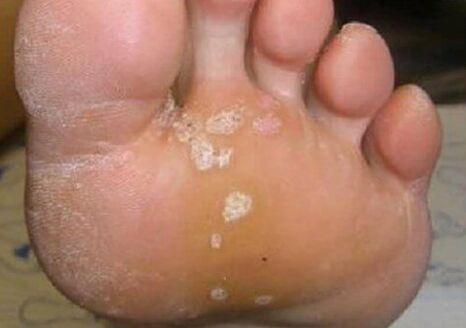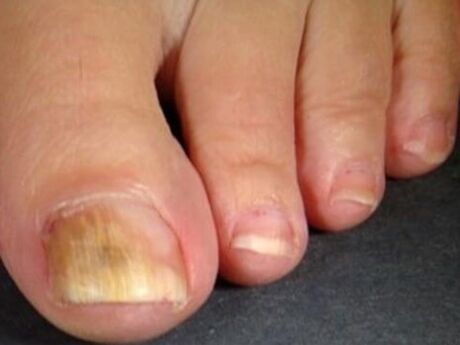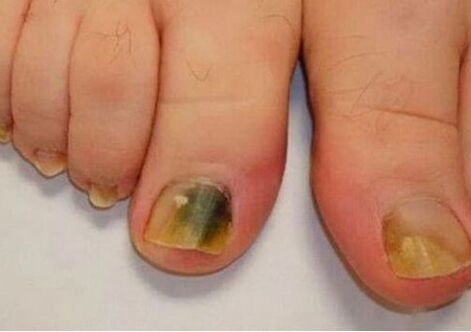The appearance of cracks between the skin of the redness, the skin of the legs, the appearance of cracks between the legs, a change in the state of nails, these and other signs show a fungal infection. Every fifth resident of the earth is sick with Mikosis. Therefore, you need to know how the mushrooms look and behave in the face of which the mushroom causes its appearance and how to treat this unpleasant disease.

In most cases, Mikosun's infection comes from a person directly to a person through the surrounding facilities. Favorable conditions for the restoration of fungi are fever and humidity. Disputes can maintain effectively in a poor condition, in a dried state after poor-controlled.
The main reasons for the disease include:
- The lack of regular foot care.
- Location with a person suffering from a mushroom.
- Using someone else's shoes and socks.
- Stop injuries.
- To visit the common areas of "mushrooms" (beaches, baths, pools).
- Inadequate processing of accessories for pedicures.
- Wear tight shoes from synthetic materials.
- Professional harmfulness (high temperature and work in humidity).
- Shoe fire in a store without a sock or a bunch.
In humans, changes in cork diseases, processing features, both inviolability, as well as local circuits, and the changes in the situation are developing faster. The reasons for the body are as follows:
- Endocrine pathology (diabetes, obesity);
- Pregnancy;
- Immune deficiency situations;
- increased sweating;
- sickness;
- vascular disorders;
- Chronic skin diseases (Ekzema, psoriasis);
- The long-term setting of medicines that squeeze immunity (corticosteroids, cytostatics).
Mushrooms in the human body, nutrition on proteins - keratin, elastin, collagen, distributing them with enzymes: keratinase. The localization of Mikoz depends on the activities of Keratinaz and various types of keratin.
Mikson in the legs lead to the species of fungi:
- Trichophyton Rubrum - Type of fungi-saprophyte living in a keratinized skin layer. Lichen causes epidermis to damage the nails in 80% of nails.
- Trichophyton mentitvites cause epidermophytius to suspend.
- Trichophyton Interdigital. In the legs, mushroom dermatophytosis, causes onyokomycosis.
- Canx's fungi affects skin and nail plates with an effective decrease in skin and nail plates with a heavy decline in immunity.

The skin lesion (sometimes called dry mushrooms) during the psoriasis (sometimes called dry mushrooms) - tend to combine on the surface with a peeling. Such elements often happen in knees, feet. This disease is not associated with a fungal infection.
The manifestations of the mushroom of the foot are divided into four main forms. The Convention is in a combination of clinical signs and the probability of transition from one time.
Leaves skin intercourse in intersigital gaps. The mushrooms of the skin of the legs show herself in the form of itching, burning, accompanied by an unpleasant odor. Often the infection affects the intervals between 3 and 4, 4 and 5 fingers to the foot. The skin becomes red, wounds, wounds, visible red between the fingers of crying areas. These symptoms are developed in the background of independent or existing scummy form.
Celebrate! Adding a second bacterial infection that further aggravates the disease for interruptionod's lesion. Bacterial, mycotic eczema is developing only by the formation of a rash not on the foot, inflammatory elements appear in ankle, falls down.
The form of an advanced skiret-hyperkerozyosis is similar to the sole, mass corn. Initially, the skin of the skin can draw attention to the skin of the skin, dry skin with dry corn. People consider such symptoms an individual feature and do not apply to a dermatologist. Skin lesions can accompany itching, burning itching. If you look at the pictures of the mushroom with the mycoz, the skin of the skin's skin is thickened and as in moccasins, as in moccasins) you can see deep cracks against the background. Such manifestations are painful. Scamous form, destruction of nail tiles, is characterized by a decline behind the nail bed.
The manifestations of the discropped (vesicular) form of foot mushrooms are rarely. The main symptom of the disease is the formation of bubbles with a thick bark and transparent content. On the sole side of the foot, they localize their fingers as single or drainage forms. Then the bubbles are opened by erosion with cotton shells around the edges. The consequences of the vesicular lesion are as follows:
- Toxic-allergic reactions. They are developing in 4-6 days, often localized symmetrically: swollen red papules can be found in foot, lower leg, front arm, face, mucous membranes.
- Relationship of the secondary bacterial or viral infection with the development of eczema.

The deleted form of fungi in feet is characterized by minimal lesions, so it is not easy to recognize it. Major signs: the formation of microcravels between the intestinal peeling, fingers, anxiety, combustion. Nail plates are involved with a long course.
Onychomycosycoz appears as a result of the skin mushrooms in the skin, when not focusing on the problem and adequate treatment.
The first symptoms and signs of the onychomycosis can also be ignored. You need to connect with nail fungus on their feet and contact a dermatologist:
- change in color of nail plates;
- appearance of yellow or gray spots;
- Bright loss;
- Appearance on the surface of irregulars;
- strips in the structure of the nail;
- the increase in fragility.
There are various classifications of onychomycosis. They are divided by the appearance of the nail plate:
- Normotrophic. The fungal infection changes the color of the nails to yellowish-gray, thickness and shape remains the same.
- Hypertrophic. These types of fungi are characterized by rough changes: nails turn yellow, thick. If you look at these types of onychomycosis, you can see a characteristic part of the tiles. Transverse studies, loosen and fragility appears outside. Such a change in nails leads to increasing. The walk becomes painful.
- Onycholithic. Nail plates become more subtle, change color, exfoliate the nail bed.
According to localization of the nail plate and localization of damage, the types of onychomycosis are different: distal; lateral; Mixed, proximal; Total; the surface.
In addition, the mushrooms of gender must be damaged. It is conventionally pathogenic mushrooms (affect the internal organs) and cause the surface micse (dermatomicosis, onyaticosis). In normal conditions, human immunity causes the increase in these fungi and increase the mass infection. Therefore, Candida's activities show itself with significant riots in the body's protection organism and require a comprehensive examination to determine the cause of immune failure. The first signs of the infection are difficult to distinguish freezing without damage.

Mushroom damage to the legs develop as follows:
- In the fingers of the legs, there is an inflammation of nail rolls, swelling of the knee, cracks on the skin, the appearance of anxiety in any movement. Under the nail plates, a cotton-separated white shade occurs.
- Inflammatory changes in the bottom of the skin are chronic. The skin around the nail stops growth. Infection affects nail plates.
- The nails in the legs begin to thicken and sprinkle. Their color is brown, brown. Lead to denying a violation of blood supply.
The diagnosis of the mushroom in the legs includes:
- Conversation with the patient (complaints, accompanying diseases, working conditions, the probability of the probability of infection).
- Checking.
- Laboratory research methods (skin, nails, microscopy, nails, nail policing, sowing nails to the candidates to ig g), sowing sensitively.
Mushrooms in the legs require treatment immediately to determine a dermatologist (or a micologist). You can perform tasks on an outpatient basis.
How and how to treat the breasts in the legs depend on a number of conditions:
- Localization of the pathological process;
- degree, severity of defeat;
- the presence of elescription diseases;
- Sick age;
- In cases of women's therapy - pregnancy, breastfeeding.
The treatment of the mushroom in the legs requires a lot of time, and its main goal is to disappear clinically and laboratory signs. Missing therapy course causes relapse of the disease.
Drug treatment helps to destroy the manifestation of inflammation and eliminate the manifestation of inflammation, using antifungal medications.
They are divided:
- Local. Apply to lesion (ointment, gel, cream, spray, varnish, solution).
- Systemic ones - orally (tablets, capsules, solutions).
In the early phase of a fungal infection, medicinal therapy is limited by the appointment of local funds. With General Mycoz, systemic antimacys are required to be closed with a heavy course.
There are many recommendations about how to get rid of mushrooms on the legs of the people and home treatment. Most include external use and some of them. However, you should not drink in the hope of bringing the neglect to mikosis, and you should not apply suspicious compositions to your feet. Such people's methods can damage health.

Celebrate! The most common for fungi and effective home treatment, salt, soda, essential oils are legs for their feet. These therapeutic procedures make legs and nails for the application of drugs.
Nail tiles will have to be removed with a mass mushroom damage. This method is safe and practically no reflection instructions. Surgical manipulation alternative - Eliminating the use of pastes and ointments to soften nails.
The use of a laser to combat onychomycosibosis is based on destroying and destroying the heater with mushrooms twisted beams. This technique allows you to treat onychomycosis, secure and applied often in patients with contraindicated in systemic treatment.
Local antifungal agents are used in legs to start the treatment of fungi. If there is no improvement in the situation after the 2-week treatment course, an antimasot agent is required. In case of severe damage, skin fungus requires a recipe for systematic drugs. Therapy continues until the fully eliminated the infection.
Nail fungi are prescribed local drugs to eliminate initial manifestations. Mikosis, which is more than 2/3 of the nail area, is a sign to adopt systematic drugs associated with the growth zone. With the mass destruction of nail slabs, the monopolic will be treated with surgical removal of the affected tissues of the nail. This method provides access to the focus of infection.
Important!
The treatment of onyokomycosis is carried before healthy nails and can last for up to 12 months.
The appearance of the mushroom in the legs can be caused by various reasons. A careful attitude to your health will help to recognize the disease in time and start treatment.



























